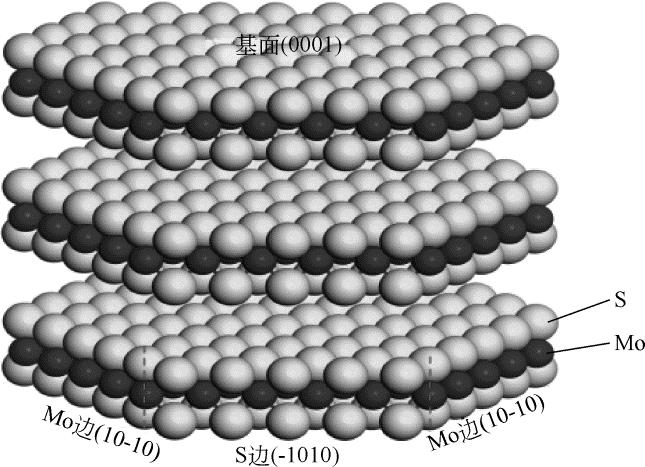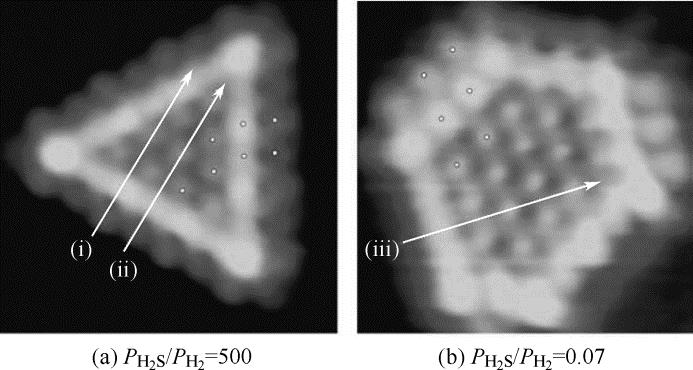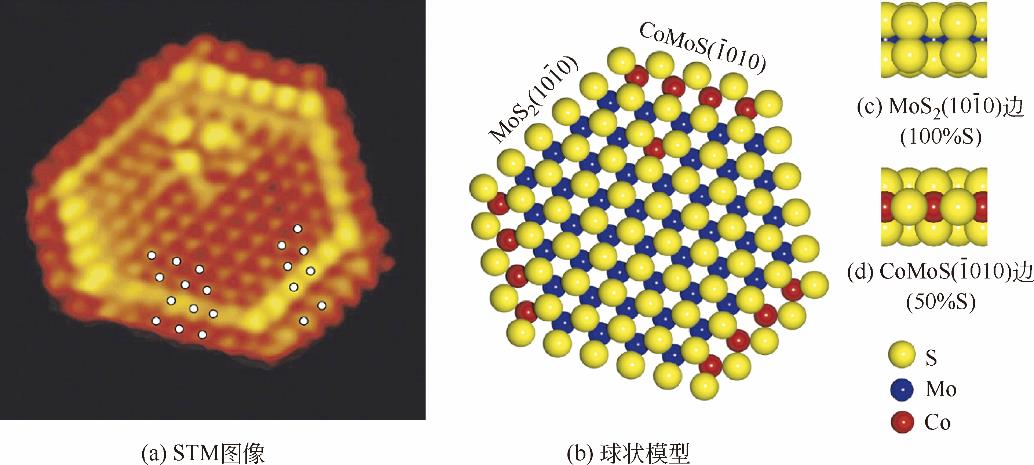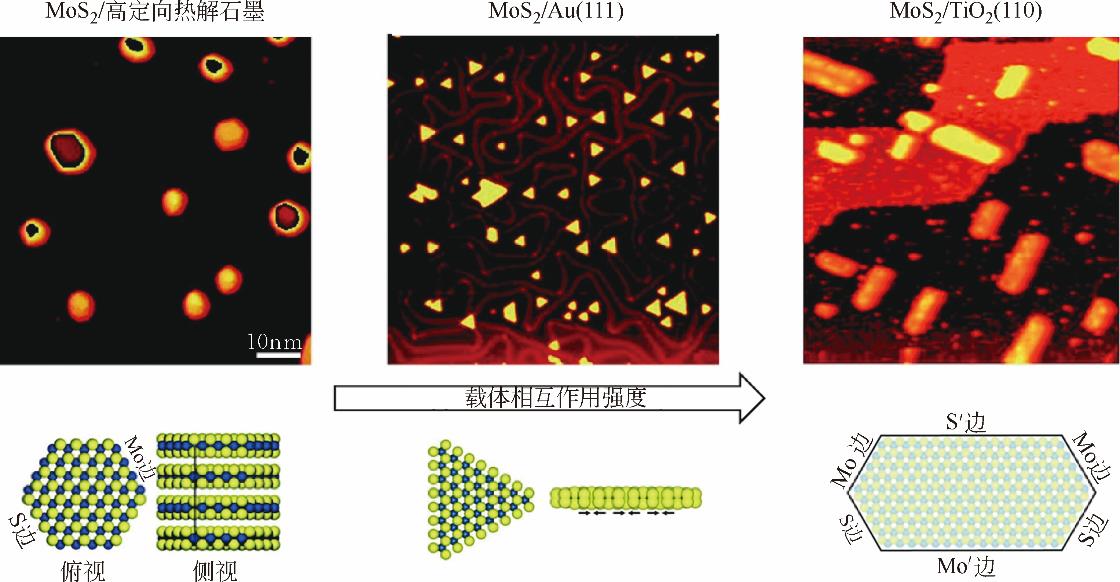Chemical Industry and Engineering Progress ›› 2019, Vol. 38 ›› Issue (02): 867-875.DOI: 10.16085/j.issn.1000-6613.2018-0324
• Industrial catalysis • Previous Articles Next Articles
Research progress in active phase structure and reaction mechanism of MoS2-based catalysts for hydrodesulfurization
Shuo LI( ),Yibin LIU,Xiang FENG,Chaohe YANG(
),Yibin LIU,Xiang FENG,Chaohe YANG( )
)
- State Key Laboratory of Heavy Oil Processing, China University of Petroleum East China, Qingdao 266580,Shandong, China
-
Received:2018-02-06Revised:2018-04-19Online:2019-02-05Published:2019-02-05 -
Contact:Chaohe YANG
MoS2基催化剂加氢脱硫反应活性相和作用机理研究进展
- 中国石油大学(华东)重质油国家重点实验室,山东 青岛 266580
-
通讯作者:杨朝合 -
作者简介:<named-content content-type="corresp-name">李硕</named-content>(1989—),男,博士研究生。E-mail:<email>lishuoupc@163.com</email>。|杨朝合,教授,从事化学反应工程、石油炼制技术、化工过程节能与优化等方面的研究。E-mail:<email>yangch@upc.edu.cn</email>。 -
基金资助:国家自然科学基金(U1462205)
CLC Number:
Cite this article
Shuo LI, Yibin LIU, Xiang FENG, Chaohe YANG. Research progress in active phase structure and reaction mechanism of MoS2-based catalysts for hydrodesulfurization[J]. Chemical Industry and Engineering Progress, 2019, 38(02): 867-875.
李硕, 刘熠斌, 冯翔, 杨朝合. MoS2基催化剂加氢脱硫反应活性相和作用机理研究进展[J]. 化工进展, 2019, 38(02): 867-875.
share this article
Add to citation manager EndNote|Ris|BibTeX
URL: https://hgjz.cip.com.cn/EN/10.16085/j.issn.1000-6613.2018-0324
| 1 | LIU B , LIU L , WANG Z , et al . Effect of hydrogen spillover in selective hydrodesulfurization of FCC gasoline over the CoMo catalyst[J]. Catalysis Today, 2017, 282: 214-221. |
| 2 | LIU L H , LIU S Q , YIN H L , et al . Hydrogen spillover effect between Ni2P and MoS2 catalysts in hydrodesulfurization of dibenzothiophene[J]. Journal of Fuel Chemistry and Technology, 2015, 43(6): 708-713. |
| 3 | 李大东 . 加氢处理工艺与工程[M]. 北京: 中国石化出版社, 2004: 93-94. |
| LI D D . Hydrotreating technology and engineering[M]. Beijing: China Petrochemical Press, 2004: 93-94. | |
| 4 | 刘丽, 郭蓉, 孙进, 等 .柴油加氢脱硫催化剂的研究进展[J].化工进展, 2016, 35(11): 3503-3510. |
| LIU L , GUO R , SUN J , et al . The research development of diesel hydrodesulfurization catalysts[J]. Chemical Industry and Engineering Progress, 2016, 35(11): 3503-3510. | |
| 5 | 王继元, 堵文斌, 陈韶辉, 等 . TiO2载体在柴油加氢脱硫中的应用进展[J]. 化工进展, 2010, 29(4): 654-658. |
| WANG J Y , DU W B , CHEN S H , et al . Progress in application of TiO2 support for catalytic diesel hydrodesulfurization[J]. Chemical Industry and Engineering Progress, 2010, 29(4): 654-658. | |
| 6 | 刘迪, 张景成, 刘晨光 .非负载型加氢精制催化剂的制备及工业应用研究进展[J].化工进展, 2010, 29(4): 643-648. |
| LIU D , ZHANG J C , LIU C G . Progress in preparation and industrial application of unsupported hydrotreating catalysts[J]. Chemical Industry and Engineering Progress, 2010, 29(4): 643-648. | |
| 7 | 仝建波, 蔺阳, 刘淑玲, 等 . 加氢脱硫催化剂载体的研究进展[J]. 化工进展, 2014, 33(5): 1170-1179. |
| TONG J B , LIN Y , LIU S L , et al . Recent progress in the support of hydrodesulfurization catalysts[J]. Chemical Industry and Engineering Progress, 2014, 35(5): 1170-1179. | |
| 8 | LIPSCH J M J G , SCHUIT G C A . The CoO MoO3 Al2O3 catalyst: Ⅱ.The structure of the catalyst[J]. Journal of Catalysis, 1969, 15(2): 174-178. |
| 9 | VOORHOEVE R J H , STUIVER J C M . The mechanism of the hydrogenation of cyclohexene and benzene on nickel-tungsten sulfide catalysts[J].Journal of Catalysis, 1971, 23(2): 243-252. |
| 10 | ASUA J M , DELMON B .Separation of the kinetic terms in catalytic reactions with varying number of active sites (case of the remote control model)[J]. Applied Catalysis, 1984, 12(2): 249-262. |
| 11 | DAAGE M , CHIANELLI R R . Structure-function relations in molybdenum sulfide catalysts: the “Rim-Edge”model[J]. Journal of Catalysis, 1994, 149: 414-427. |
| 12 | TOPSOEE H , CLAUSEN B S , NAN Y T, et al . Recent basic research in hydrodesulfurization catalysis[J]. Industrial & Engineering Chemistry Fundamentals, 1986, 25(1): 25-36. |
| 13 | TOPSØE H , CLAUSEN B S , CANDIA R , et al . In situ Mössbauer emission spectroscopy studies of unsupported and supported sulfided CoMo hydrodesulfurization catalysts: evidence for and nature of a CoMoS phase[J]. Journal of Catalysis, 1981, 68(2): 433-452. |
| 14 | MAUGÉ F , DUCHET J C , LAVALLEY J C , et al . The sulphided state of nickel molybdenum catalysts supported on zirconia and aluminates[J]. Catalysis Today, 1991, 10(91): 561-577. |
| 15 | CALAIS C , MATSUBAYASHI N , GEANTET C , et al . Crystallite size determination of highly dispersed unsupported MoS2 catalysts[J]. Journal of Catalysis, 1998, 174(2): 130-141. |
| 16 | SHIDO T , PRINS R . Why EXAFS underestimated the size of small supported MoS2 particles[J]. The Journal of Physical Chemistry B, 1998, 102(43): 8426-8435. |
| 17 | KONG D S , WANG H T , CHA J J, et al . Synthesis of MoS2 and MoSe2 films with vertically aligned layers[J]. Nano Letters, 2013, 13(3): 1341-1347. |
| 18 | TOPSØE H , CLAUSEN B S , MASSOTH F E . Hydrotreating catalysis[M]. Berlin: Springer-Verlag, 1996. |
| 19 | DING S J , ZHOU Y S , WEI Q , et al . Substituent effects of 4,6-DMDBT on direct hydrodesulfurization routes catalyzed by Ni-Mo-S active nanocluster-A theoretical study[J]. Catalysis Today, 2018, 305: 28-39. |
| 20 | HAANDEL L V , BREMMER G M , HENSEN E J M , et al . Influence of sulfiding agent and pressure on structure and performance of CoMo/Al2O3 hydrodesulfurization catalysts[J]. Journal of Catalysis, 2016, 342: 27-39. |
| 21 | LAURITSEN J V , BOLLINGER M V , LÆGSGAARD E , et al . Atomic-scale insight into structure and morphology changes of MoS2 nanoclusters in hydrotreating catalysts[J]. Journal of Catalysis, 2004, 221(2): 510-522. |
| 22 | LIU B , CHAI Y M , LI Y P , et al . Effect of sulfidation atmosphere on the performance of the CoMo/γ-Al2O3 catalysts in hydrodesulfurization of FCC gasoline[J]. Applied Catalysis A: General, 2014, 471: 70-79. |
| 23 | RAYBAUD P , HAFNER J , KRESSE G , et al . Ab initio study of the H2-H2S/MoS2 gas-solid interface: the nature of the catalytically active sites[J]. Journal of Catalysis, 2000, 189(1): 129-146. |
| 24 | SCHWEIGER H , RAYBAUD P , KRESSE G , et al . Shape and edge sites modifications of MoS2 catalytic nanoparticles induced by working conditions: a theoretical study[J]. Journal of Catalysis, 2002, 207(1): 76-87. |
| 25 | MOSES P G , HINNEMANN B , TOPSØE H , et al . The hydrogenation and direct desulfurization reaction pathway in thiophene hydrodesulfurization over MoS2 catalysts at realistic conditions: a density functional study[J]. Journal of Catalysis, 2007, 248(2): 188-203. |
| 26 | 鞠雅娜, 兰玲, 刘坤红, 等 . 催化裂化汽油深度加氢脱硫催化剂的研制及性能评价[J]. 化工进展, 2017, 36(7): 2511-2516. |
| JU Y N , LAN L , LIU K H , et al . Preparation and evaluation of a deep hydrodesulfurization(HDS) catalyst for catalytic cracking gasoline[J]. Chemical Industry and Engineering Progress, 2017, 36(7): 2511-2516. | |
| 27 | KIBSGAARD J , TUXEN A , KNUDSEN K G , et al . Comparative atomic-scale analysis of promotional effects by late 3D-transition metals in MoS2 hydrotreating catalysts[J]. Journal of Catalysis, 2010, 272(2): 195-203. |
| 28 | LAURITSEN J V , KIBSGAARD J , OLESEN G H , et al . Location and coordination of promoter atoms in Co- and Ni-promoted MoS2-based hydrotreating catalysts[J]. Journal of Catalysis, 2007, 249(2): 220-233. |
| 29 | KREBS E , SILVI B , RAYBAUD P . Mixed sites and promoter segregation: a DFT study of the manifestation of Le Chatelier’s principle for the Co(Ni)MoS active phase in reaction conditions[J]. Catalysis Today, 2008, 130(1): 160-169. |
| 30 | BARA C , LAMIC-HUMBLOT A F , FONDA E , et al . Surface-dependent sulfidation and orientation of MoS2 slabs on alumina-supported model hydrodesulfurization catalysts[J]. Journal of Catalysis, 2016, 344: 591-605. |
| 31 | LAURITSEN J V , JACOBSEN K W , NØRSKOV J K , et al . One-dimensional metallic edge states in MoS2 [J]. Physical Review Letters, 2001, 87(19): 196803. |
| 32 | COSTA D , ARROUVEL C , BREYSSE M , et al . Edge wetting effects of γ Al2O3 and anatase-TiO2 supports by MoS2 and CoMoS active phases: a DFT study[J]. Journal of Catalysis, 2007, 246(2): 325-343. |
| 33 | WALTON A S , LAURITSEN J V , TOPSØE H , et al . MoS2 nanoparticle morphologies in hydrodesulfurization catalysis studied by scanning tunneling microscopy[J]. Journal of Catalysis, 2013, 308: 306-318. |
| 34 | KIBSGAARD J , LAURITSEN J V , LÆGSGAARD E , et al . Cluster-support interactions and morphology of MoS2 nanoclusters in a graphite-supported hydrotreating model catalyst[J]. Journal of the American Chemical Society, 2006, 128(42): 13950-13958. |
| 35 | KIBSGAARD J , CLAUSEN B S , TOPSØE H , et al . Scanning tunneling microscopy studies of TiO2-supported hydrotreating catalysts: anisotropic particle shapes by edge-specific MoS2-support bonding[J]. Journal of Catalysis, 2009, 263(1): 98-103. |
| 36 | LI Y , LI A T , LI F F , et al . Application of HF etching in a HRTEM study of supported MoS2 catalysts[J]. Journal of Catalysis, 2014, 317: 240-252. |
| 37 | KOLBOE S . Catalytic hydrodesulfurization of thiophene: Ⅶ. Comparison between thiophene, tetrahydrothiophene, and n-butanethiol[J]. Canadian Journal of Chemistry, 1969, 47(2): 352-355. |
| 38 | AMBERG C H . Molybdenum in hydrodesulphurisation catalysts[J]. Journal of the Less Common Metals, 1974, 6(1/2): 339-352. |
| 39 | KRAUS J , ZDRAŽIL M . Tetrahydrothiophene as intermediate in the hydrodesulfurization of thiophene[J]. Reaction Kinetics and Catalysis Letters, 1977, 6(4): 475-480. |
| 40 | KIERAN P , KEMBALL C . Some catalytic reactions of thiophene on disulfides of tungsten and molybdenum[J]. Journal of Catalysis, 1965, 4(3): 394-402. |
| 41 | NØRSKOV J K , CLAUSEN B S , TOPSØE H . Understanding the trends in the hydrodesulfurization activity of the transition metal sulfides[J]. Catalysis Letters, 1992, 13(1): 1-8. |
| 42 | NAGAI M , SATO T , AIBA A . Poisoning effect of nitrogen compounds on dibenzothiophene hydrodesulfurization on sulfided NiMoAl2O3 catalysts and relation to gas-phase basicity[J]. Journal of Catalysis, 1986, 97(1): 52-58. |
| 43 | VOPA V L , SATTERFIELD C N . Poisoning of thiophene hydrodesulfurization by nitrogen compounds[J]. Journal of Catalysis, 1988, 110(2): 375-387. |
| 44 | RANGARAJAN S , MAVRIKAKIS M . DFT insights into the competitive adsorption of sulfur-and nitrogen-containing compounds and hydrocarbons on Co-promoted molybdenum sulfide catalysts[J]. ACS Catalysis, 2016, 6(5): 2904-2917. |
| 45 | PRINS R , EGOROVA M , RÖTHLISBERGER A , et al . Mechanisms of hydrodesulfurization and hydrodenitrogenation[J]. Catalysis Today, 2006, 111(1/2): 84-93. |
| 46 | EGOROVA M , PRINS R . Hydrodesulfurization of dibenzothiophene and 4,6-dimethyldibenzothiophene over sulfided NiMo/γ Al2O3, CoMo/γ-Al2O3, and Mo/γ-Al2O3 catalysts[J]. Journal of Catalysis, 2004, 225(2): 417-427. |
| 47 | RANGARAJAN S , MAVRIKAKIS M . On the preferred active sites of promoted MoS2 for hydrodesulfurization with minimal organonitrogen inhibition[J]. ACS Catalysis, 2016, 7(1): 501-509. |
| 48 | LAURITSEN J V , NYBERG M , VANG R T . Chemistry of one-dimensional metallic edge states in MoS2 nanoclusters[J]. Nanotechnology, 2003, 14(3): 385. |
| 49 | LAURITSEN J V , NYBERG M , NØRSKOV J K , et al . Hydrodesulfurization reaction pathways on MoS2 nanoclusters revealed by scanning tunneling microscopy[J]. Journal of Catalysis, 2004, 224(1): 94-106. |
| 50 | SULLIVAN D L , EKERDT J G . Mechanisms of thiophene hydrodesulfurization on model molybdenum catalysts[J]. Journal of Catalysis, 1998, 178(1): 226-233. |
| 51 | LIU B , ZHAO Z , WANG D X , et al . A theoretical study on the mechanism for thiophene hydrodesulfurization over zeolite L-supported sulfided Co-Mo catalysts: insight into the hydrodesulfurization over zeolite-based catalysts[J]. Computational & Theoretical Chemistry, 2015, 1052: 47-57. |
| 52 | MARKEL E J , SCHRADER G L , SAUER N N , et al . Thiophene, 2,3- and 2,5-dihydrothiophene and tetrahydrothiophene hydrodesulfurization on Mo and Re γ Al2O3 catalysts[J]. Journal of Catalysis, 1989, 116(1): 11-22. |
| 53 | BORGNA A , HENSEN E J M , COULIER L , et al . Intrinsic thiophene hydrodesulfurization kinetics of a sulfided NiMo/SiO2 model catalyst: volcano-type behavior[J]. Catalysis Letters, 2003, 90(3): 117-122. |
| 54 | VRINAT M L . The kinetics of the hydrodesulfurization process - a review[J]. Applied Catalysis, 1983, 6(2): 137-158. |
| 55 | SCHULZ H , DO D . Fast and slow steps of hydrodesulfurization[J]. Bulletin des Sociétés Chimiques Belges, 1984, 93(8/9): 645-652. |
| 56 | MOSES P G , HINNEMANN B , TOPSØE H , et al . Corrigendum to“The hydrogenation and direct desulfurization reaction pathway in thiophene hydrodesulfurization over MoS2 catalysts at realistic conditions: a density functional study” [Journal of Catalysis, 2007, 248: 188][J]. Journal of Catalysis, 2008, 260(1): 202-203. |
| 57 | MOSES P G , HINNEMANN B , TOPSØE H , et al . The effect of Co-promotion on MoS2 catalysts for hydrodesulfurization of thiophene: a density functional study[J]. Journal of Catalysis, 2009, 268(2): 201-208. |
| 58 | GRØNBORG S S , ŠARIĆ M , MOSES P G , et al . Atomic scale analysis of sterical effects in the adsorption of 4, 6-dimethyldibenzothiophene on a CoMoS hydrotreating catalyst[J]. Journal of Catalysis, 2016, 344: 121-128. |
| 59 | ZHENG P , DUAN A J , CHI K B , et al . Influence of sulfur vacancy on thiophene hydrodesulfurization mechanism at different MoS2 edges: a DFT study[J]. Chemical Engineering Science, 2017, 164: 292-306. |
| 60 | DING S J , JIANG S J , ZHOU Y S , et al . Catalytic characteristics of active corner sites in CoMoS nanostructure hydrodesulfurization-a mechanism study based on DFT calculations[J]. Journal of Catalysis, 2017, 345: 24-38. |
| 61 | CHEN J J , MAUGÉ F , FALLAH J E , et al . IR spectroscopy evidence of MoS2, morphology change by citric acid addition on MoS2/Al2O3 catalysts-a step forward to differentiate the reactivity of M-edge and S-edge[J]. Journal of Catalysis, 2014, 320(1): 170-179. |
| 62 | HUANG T T , XU J D , FAN Y . Effects of concentration and microstructure of active phases on the selective hydrodesulfurization performance of sulfided CoMo/Al2O3 catalysts[J]. Applied Catalysis B: Environmental, 2017, 220: 42-56. |
| 63 | LI P , CHEN Y D , ZHANG C , et al . Highly selective hydrodesulfurization of gasoline on unsupported Co-Mo sulfide catalysts: effect of MoS2 morphology[J]. Applied Catalysis A: General, 2017, 533: 99-108. |
| [1] | ZHANG Mingyan, LIU Yan, ZHANG Xueting, LIU Yake, LI Congju, ZHANG Xiuling. Research progress of non-noble metal bifunctional catalysts in zinc-air batteries [J]. Chemical Industry and Engineering Progress, 2023, 42(S1): 276-286. |
| [2] | SHI Yongxing, LIN Gang, SUN Xiaohang, JIANG Weigeng, QIAO Dawei, YAN Binhang. Research progress on active sites in Cu-based catalysts for CO2 hydrogenation to methanol [J]. Chemical Industry and Engineering Progress, 2023, 42(S1): 287-298. |
| [3] | XIE Luyao, CHEN Songzhe, WANG Laijun, ZHANG Ping. Platinum-based catalysts for SO2 depolarized electrolysis [J]. Chemical Industry and Engineering Progress, 2023, 42(S1): 299-309. |
| [4] | YANG Xiazhen, PENG Yifan, LIU Huazhang, HUO Chao. Regulation of active phase of fused iron catalyst and its catalytic performance of Fischer-Tropsch synthesis [J]. Chemical Industry and Engineering Progress, 2023, 42(S1): 310-318. |
| [5] | ZHENG Qian, GUAN Xiushuai, JIN Shanbiao, ZHANG Changming, ZHANG Xiaochao. Photothermal catalysis synthesis of DMC from CO2 and methanol over Ce0.25Zr0.75O2 solid solution [J]. Chemical Industry and Engineering Progress, 2023, 42(S1): 319-327. |
| [6] | WANG Zhengkun, LI Sifang. Green synthesis of gemini surfactant decyne diol [J]. Chemical Industry and Engineering Progress, 2023, 42(S1): 400-410. |
| [7] | WANG Lele, YANG Wanrong, YAO Yan, LIU Tao, HE Chuan, LIU Xiao, SU Sheng, KONG Fanhai, ZHU Canghai, XIANG Jun. Influence of spent SCR catalyst blending on the characteristics and deNO x performance for new SCR catalyst [J]. Chemical Industry and Engineering Progress, 2023, 42(S1): 489-497. |
| [8] | DENG Liping, SHI Haoyu, LIU Xiaolong, CHEN Yaoji, YAN Jingying. Non-noble metal modified vanadium titanium-based catalyst for NH3-SCR denitrification simultaneous control VOCs [J]. Chemical Industry and Engineering Progress, 2023, 42(S1): 542-548. |
| [9] | GENG Yuanze, ZHOU Junhu, ZHANG Tianyou, ZHU Xiaoyu, YANG Weijuan. Homogeneous/heterogeneous coupled combustion of heptane in a partially packed bed burner [J]. Chemical Industry and Engineering Progress, 2023, 42(9): 4514-4521. |
| [10] | CHENG Tao, CUI Ruili, SONG Junnan, ZHANG Tianqi, ZHANG Yunhe, LIANG Shijie, PU Shi. Analysis of impurity deposition and pressure drop increase mechanisms in residue hydrotreating unit [J]. Chemical Industry and Engineering Progress, 2023, 42(9): 4616-4627. |
| [11] | WANG Peng, SHI Huibing, ZHAO Deming, FENG Baolin, CHEN Qian, YANG Da. Recent advances on transition metal catalyzed carbonylation of chlorinated compounds [J]. Chemical Industry and Engineering Progress, 2023, 42(9): 4649-4666. |
| [12] | GAO Yanjing. Analysis of international research trend of single-atom catalysis technology [J]. Chemical Industry and Engineering Progress, 2023, 42(9): 4667-4676. |
| [13] | ZHANG Qi, ZHAO Hong, RONG Junfeng. Research progress of anti-toxicity electrocatalysts for oxygen reduction reaction in PEMFC [J]. Chemical Industry and Engineering Progress, 2023, 42(9): 4677-4691. |
| [14] | GE Quanqian, XU Mai, LIANG Xian, WANG Fengwu. Research progress on the application of MOFs in photoelectrocatalysis [J]. Chemical Industry and Engineering Progress, 2023, 42(9): 4692-4705. |
| [15] | WANG Weitao, BAO Tingyu, JIANG Xulu, HE Zhenhong, WANG Kuan, YANG Yang, LIU Zhaotie. Oxidation of benzene to phenol over aldehyde-ketone resin based metal-free catalyst [J]. Chemical Industry and Engineering Progress, 2023, 42(9): 4706-4715. |
| Viewed | ||||||
|
Full text |
|
|||||
|
Abstract |
|
|||||









